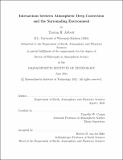| dc.contributor.advisor | Cronin, Timothy W. | |
| dc.contributor.author | Abbott, Tristan H. | |
| dc.date.accessioned | 2022-01-14T15:04:22Z | |
| dc.date.available | 2022-01-14T15:04:22Z | |
| dc.date.issued | 2021-06 | |
| dc.date.submitted | 2021-06-14T18:13:09.037Z | |
| dc.identifier.uri | https://hdl.handle.net/1721.1/139328 | |
| dc.description.abstract | Atmospheric deep convection is a central player in Earth's climate, influencing the vertical distribution of energy and moisture in the atmosphere, modulating the hydrological cycle, and altering Earth's energy balance. However, many interactions between convection and other components of the climate system remain poorly understood and poorly simulated in global climate models. Motivated by this challenge, I present work on several topics related to the coupling between atmospheric deep convection and the surrounding environment.
First, I explore the effects of global warming on convective precipitation extremes. I show that, in idealized convection-permitting simulations, updraft velocity profiles associated with extreme precipitation collapse to a climate-invariant shape when plotted in a moisture-based vertical coordinate. I then leverage the collapse to better understand the success of a "Clausius-Clapeyron" scaling of precipitation extremes with surface specific humidity, providing a foundation for its use as a baseline prediction for changes in extreme rainfall in a warming world.
Second, I focus on explaining observations that suggest a link between high atmospheric aerosol concentrations and more vigorous deep convection. Based on a combination of convection-permitting simulations and simple scale analysis, I argue that the link may arise through a novel "humidity-entrainment" mechanism that relies on a two-way coupling between clouds and clear-air humidity.
Finally, I examine the response of convection over tropical land to large perturbations in atmospheric humidity, with an emphasis on the potential for bistability. Similar to past studies of convection over tropical oceans, I find that convection-permitting simulations over a moist land-like surface support both precipitating equilibria (attained when initialized with a humid atmosphere) and non-precipitating equilibria (attained when initialized with a dry atmosphere). However, I also find that soil moisture feedbacks—a distinctive feature of land surfaces—can destabilize non-precipitating equilibria when uneven surface drying produces spatial soil moisture gradients. This negative soil moisture-precipitation feedback arises from the effects of mesoscale circulations on the boundary layer moisture budget, highlighting a potentially-important role for surface heterogeneity in limiting the duration of dry spells over tropical land. | |
| dc.publisher | Massachusetts Institute of Technology | |
| dc.rights | In Copyright - Educational Use Permitted | |
| dc.rights | Copyright MIT | |
| dc.rights.uri | http://rightsstatements.org/page/InC-EDU/1.0/ | |
| dc.title | Interactions between Atmospheric Deep Convection and the Surrounding Environment | |
| dc.type | Thesis | |
| dc.description.degree | Ph.D. | |
| dc.contributor.department | Massachusetts Institute of Technology. Department of Earth, Atmospheric, and Planetary Sciences | |
| dc.identifier.orcid | https://orcid.org/0000-0001-5486-3993 | |
| mit.thesis.degree | Doctoral | |
| thesis.degree.name | Doctor of Philosophy | |
